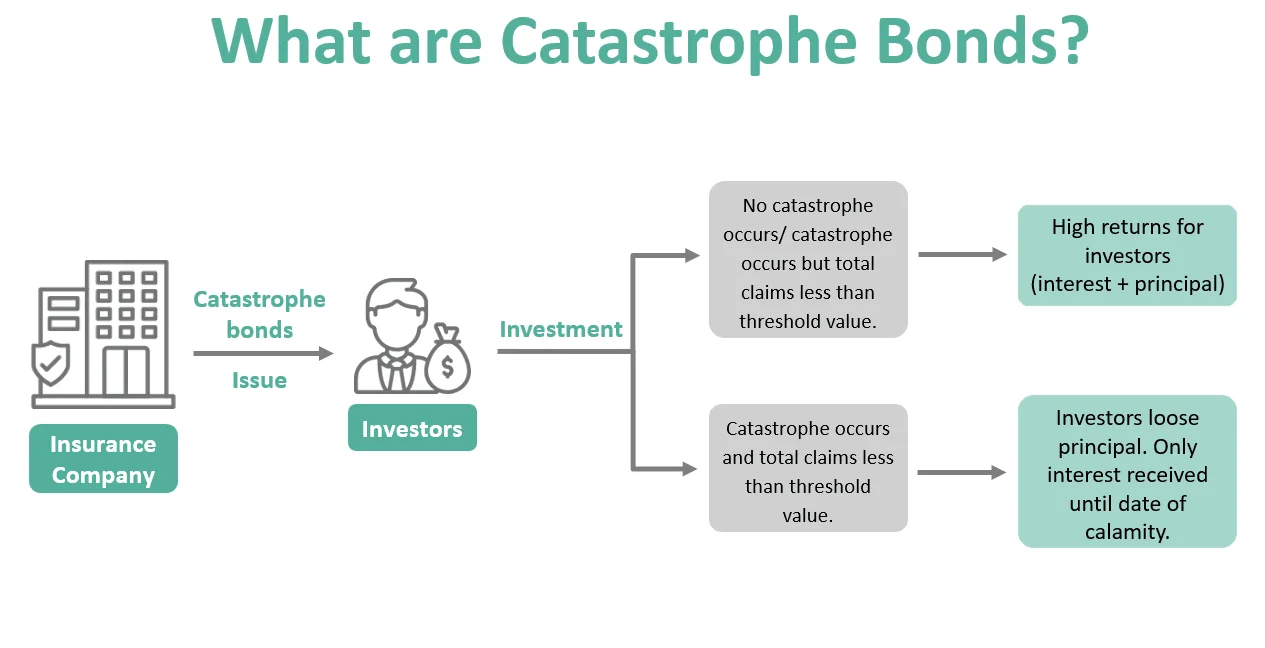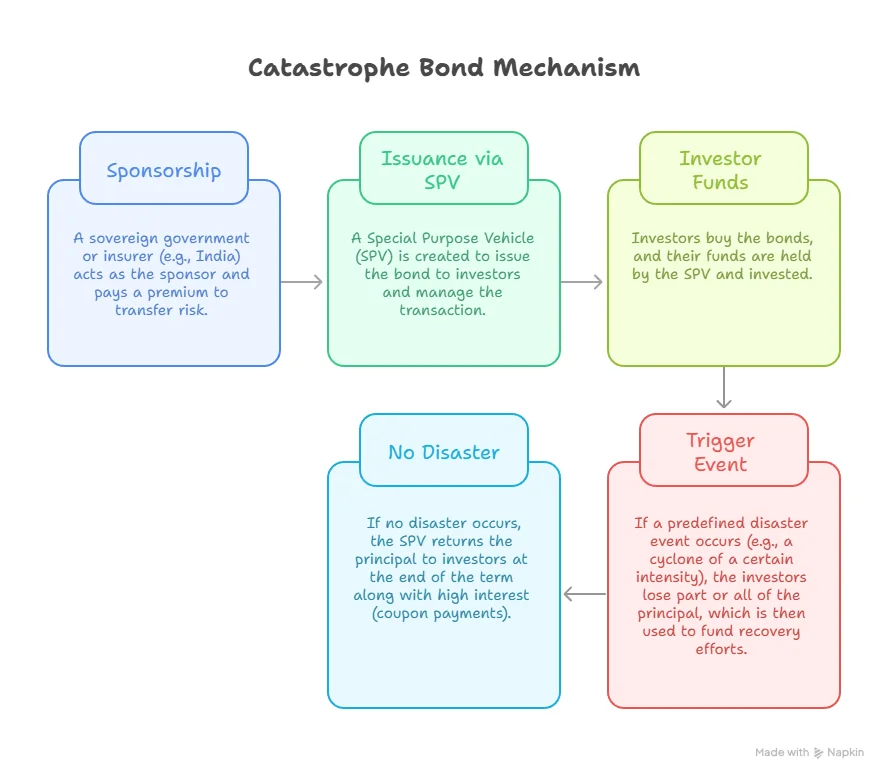Catastrophe Bonds for Natural Disasters | 15 Jul 2025
Why in News?
India’s limited disaster insurance coverage increases financial vulnerability during natural disasters. In light of rising climate-induced disasters, Catastrophe Bonds (Cat Bonds) present a strategic option for enhancing disaster risk financing and resilience.
Bonds
- Bonds are debt instruments where an investor lends money to a government, corporation, or other entity for a fixed period.
- In return, the investor receives regular interest payments (called coupons) and gets back the principal amount at the end of the bond’s term (maturity).
What are Catastrophe Bonds?
- About: Catastrophe Bonds are insurance-linked securities that transfer the financial risk of natural disasters (earthquakes, cyclones, or floods) from governments or insurers to private investors through global financial markets.
- These hybrid instruments combine insurance and bond features, raising quick funds for post-disaster relief.
- Investors earn high returns for bearing the risk but may lose their investment if a major disaster occurs.
- Primarily purchased by institutional investors like pension funds and hedge funds due to their complexity and high investment thresholds.
- Cat-bonds are now increasingly attracting retail investors, especially after becoming the best-performing hedge fund strategy in 2023.
- Working Mechanism:
- Key Features:
- High Returns: Investors are compensated with higher returns than regular government or corporate bonds, due to the risk of losing the principal.
- Diversification: Cat bond risks are not correlated with financial market movements, offering diversification.
- Quick Capital Mobilization: Enables faster payouts post-disaster, reducing dependence on delayed aid or budget reallocation.
- Multi-Year Coverage: Can provide multi-year disaster protection for governments.
- Fiscal Buffer: Reduces pressure on central and state government finances after disasters.
- Investor Vigilance: Encourages improved disaster preparedness and investment in risk mitigation technologies.
- Global Trends: Since their inception in the late 1990s, over USD 180 billion in Cat Bonds have been issued globally, with around USD 50 billion currently active.
What is the Significance of Catastrophe Bonds for India?
- India, being highly vulnerable to climate-related disasters such as cyclones, floods, and earthquakes, faces rising challenges in disaster risk financing as insurers raise premiums or exit the market.
- Since FY 2021-22, the government has been allocating USD 1.8 billion annually for disaster mitigation, making India well-positioned to explore Cat Bonds potentially in partnership with intermediaries like the World Bank or Asian Development Bank (ADB).
- India can lead a South Asian Cat Bond initiative to cover transboundary disaster risks like earthquakes in Nepal, Bhutan, and India, or cyclones impacting India, Bangladesh, and Sri Lanka.
- A regional approach would spread risk, reduce premium costs, and enhance financial resilience against natural disasters across participating countries.
UPSC Civil Services Examination, Previous Year Question (PYQ)
Q.1 In the context of the Indian economy, non-financial debt includes which of the following? (2020)
- Housing loans owed by households
- Amounts outstanding on credit cards
- Treasury bills
Select the correct answer using the code given below:
(a) 1 only
(b) 1 and 2 only
(c) 3 only
(d) 1, 2 and 3
Ans: (d)
Q.2 Consider the following statements: (2018)
- The Reserve Bank of India manages and services Government of India Securities but not any State Government Securities.
- Treasury bills are issued by the Government of India and there are no treasury bills issued by the State Governments.
- Treasury bills offer are issued at a discount from the par value.
Which of the statements given above is/are correct?
(a) 1 and 2 only
(b) 3 only
(c) 2 and 3 only
(d) 1, 2 and 3
Ans: (c)
Q.3 In the context of Indian economy, ‘Open Market Operations’ refers to (2013)
(a) borrowing by scheduled banks from the RBI
(b) lending by commercial banks to industry and trade
(c) purchase and sale of government securities by the RBI
(d) None of the above
Ans: (c)


